Players, Men and Women
BlackPast has partnered with the National Bobblehead Hall of Fame and Museum in Milwaukee, Wisconsin to bring you bobbleheads of Negro Baseball League players and teams from 1920 to 1950. Each bobblehead that appears below is linked to the BP entry on that player or team. Proceeds from the sale of these bobbleheads go to the Negro Baseball League Museum in Kansas City, the families of the players you see below, and to BlackPast.org.
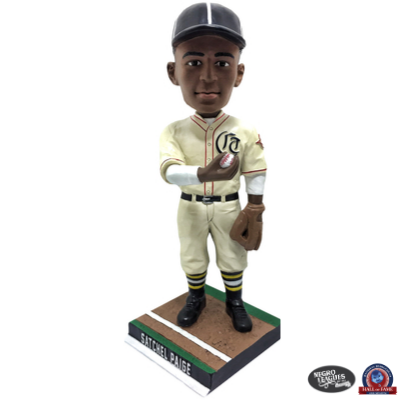
Leroy “Satchel” Paige
Leroy Robert “Satchel” Paige, one of the few African American baseball athletes to play in both the Negro Baseball Leagues and in Major League Baseball. He was also the first player to be inducted into the Baseball Hall of Fame because of his career in the Negro Leagues.
Read More
Buy this bobblehead from the Bobblehead Hall of Fame.
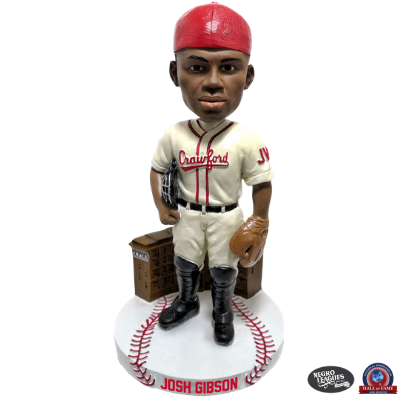
Josh Gibson
Josh Gibson was born in Buena Vista, Georgia, on December 21, 1911. He moved to Pittsburgh in 1924 when his father found work in a steel mill. He played baseball for company teams in the area but began his career with the Negro League when he signed with the Pittsburgh Crawfords. He played for the Crawfords from 1927 to 1929 and from 1932 to 1936. In an era of segregation, Josh Gibson was known as the “Black Babe Ruth.”
Read More
Buy this bobblehead from the Bobblehead Hall of Fame.
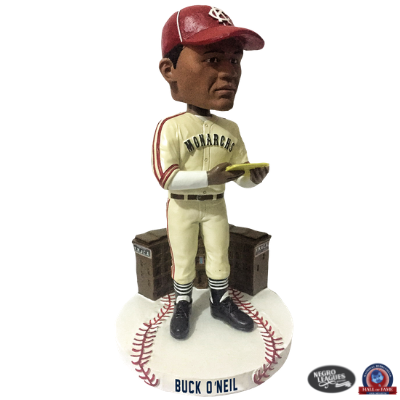
John Jordan “Buck” O’Neil
John Jordan “Buck” O’Neil was born November 13, 1911, in Carrabelle, Florida. Working with his father on a Florida celery farm when he was 13, the young O’Neil said to himself “Damn. There’s got to be something better than this.” After traveling to West Palm Beach to see Rube Foster’s baseball team at the Royal Poinciana Hotel, O’Neil decided baseball was going to be his way out.
Read More
Buy this bobblehead from the Bobblehead Hall of Fame.
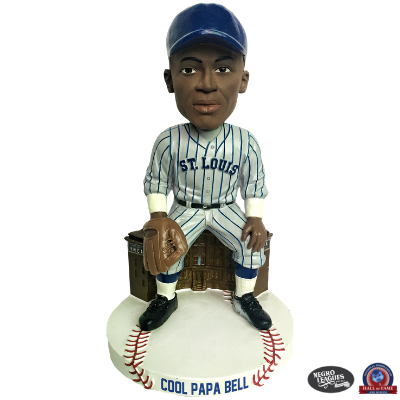
James “Cool Papa” Bell
James Thomas Bell was born May 17, 1903, in Starkville, Mississippi. Playing baseball as a 19 year-old rookie Bell earned the nickname “Cool Papa” after proving to his older teammates that he was not intimidated by playing professionally in front of large crowds. Signing with the St. Louis Stars in 1922, Bell entered professional baseball as a pitcher, reportedly throwing a wicked curveball and fade-away knuckleball.
Read More.
Buy this bobblehead from the Bobblehead Hall of Fame.
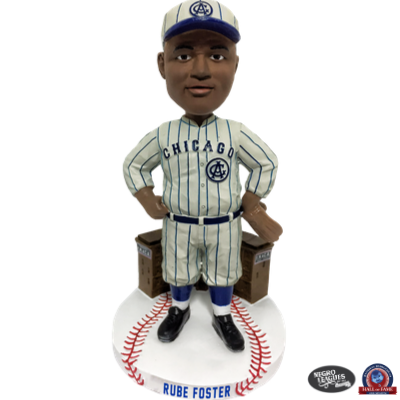
Andrew Rube Foster
Andrew Rube Foster was born in Calvert, Texas, on September 17, 1879. The son of Andrew and Sarah Foster, Rube started a baseball tradition that would be followed by his brother Willie Bill Foster. Rube quit school after the eighth grade, barnstorming with the Waco Yellow Jackets, an independent black team in 1897. By 1902, Rube’s baseball abilities gave him an opportunity to play with the Chicago (Illinois) Union Giants.
Read More
Buy this bobblehead from the Bobblehead Hall of Fame.
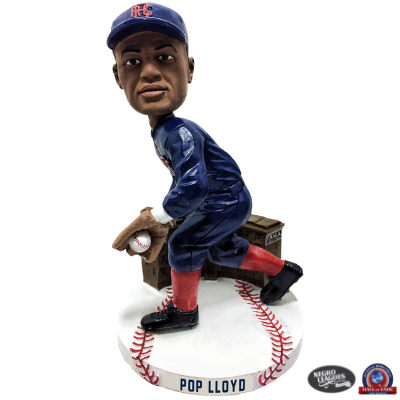
John Henry “Pop” Lloyd
John Henry “Pop” Lloyd was born April 25, 1884, in Palatka, Florida. Reportedly discovered by baseball legend Rube Foster, Lloyd would begin his professional career with the Cuban X-Giants, where fans would give him the nickname “El Cuchara” (“The Shovel”) due to his steady hands and ability to grab any ground ball coming at him. His tremendous play at shortstop would be matched by only one other player, Hall-of-Famer Honus Wagner, who declared “it is a privilege to have been compared to him.”
Read More
Buy this bobblehead from the Bobblehead Hall of Fame.
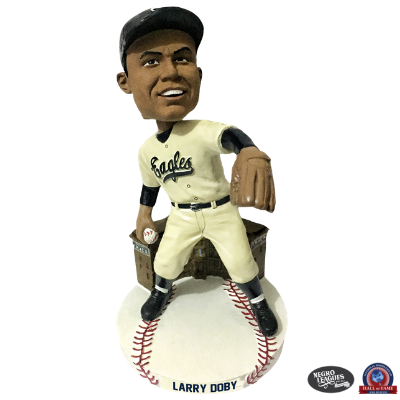
Larry Doby
Larry Doby was the first African American baseball player to go directly from the Negro Leagues to the major leagues when the Cleveland Indians purchased his contract from the Newark Eagles on July 3, 1947. Two days later, on July 5, 1947, Larry Doby became the first African American to play in the American League, making his debut fewer than three months after the landmark date of April 15, 1947, when Jackie Robinson became the first African American player in the modern history of Major League Baseball.
Read More
Buy this bobblehead from the Bobblehead Hall of Fame.
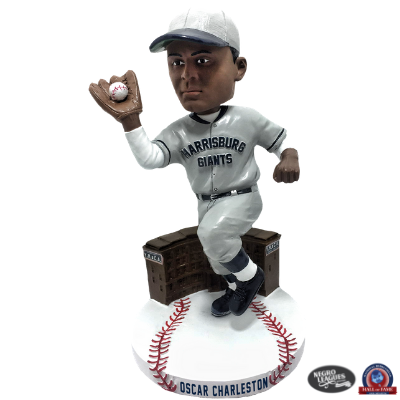
Oscar Charleston
Oscar Charleston was born October 14, 1896, in Indianapolis, Indiana. Growing up as a batboy for the local Indianapolis ABC’s, Charleston was a runaway who joined the Army at age 15. Stationed in the Philippines, Charleston was given the opportunity to play baseball and run track for the Army, where he ran the 220-yard dash in 23 seconds. While there, Charleston was allowed to play in the usually all-white Manila League.
Read More
Buy this bobblehead from the Bobblehead Hall of Fame.
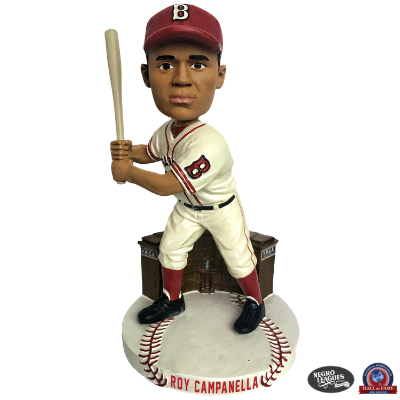
Roy Campanella
Roy Campanella was an African American baseball player who helped break the color barrier in Major League Baseball (MLB), becoming the first African American catcher in MLB when he signed with the Brooklyn Dodgers. Campanella, nicknamed “Campy,” was born on November 19, 1921 in Philadelphia, Pennsylvania, to John Campanella, an Italian American father, and Ida Campanella, his African American mother. Because he was racially classified as black he was forced to play in the Negro Leagues until 1947.
Read More
Buy this bobblehead from the Bobblehead Hall of Fame.
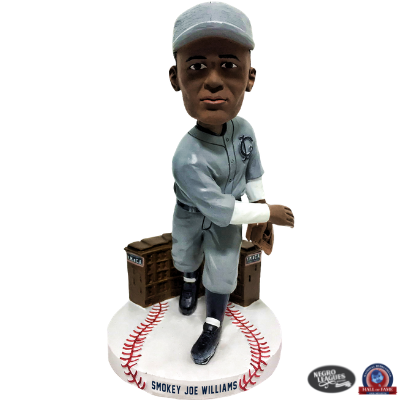
Smokey Joe Williams
Born Joseph Williams in Sequin, Texas on April 6, 1886, “Smokey” Joe Williams (also known as “Cyclone” Joe Williams) is regarded as one of the greatest of the black baseball pitchers. In 1952, when the Pittsburgh Courier asked a panel of veterans and sports writers to name the best Negro League pitcher of all time, Smokey Joe Williams was the winner over Satchel Paige, 20-19. He stood 6’5” and had a variety of power pitches but was best known for his fastball.
Read More
Buy this bobblehead from the Bobblehead Hall of Fame.
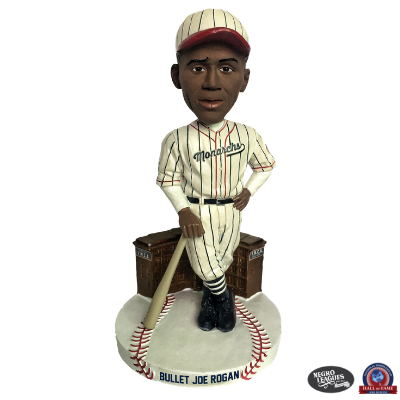
Charles Wilber “Bullet” Rogan
Charles Wilber “Bullet” Rogan, also known as Bullet Joe, was a pitcher and outfielder who played most of his baseball career for the Kansas City Monarchs in the Negro Baseball Leagues. In 1923, with the Kansas City Monarchs, his batting average was .364 and he had a league-leading 16 wins and 151 strikeouts as a pitcher. He led the Monarchs to their first pennant. The following year, Rogan hit .395 and the team completed the season with a 18-6 record.
Read More
Buy this bobblehead from the Bobblehead Hall of Fame.
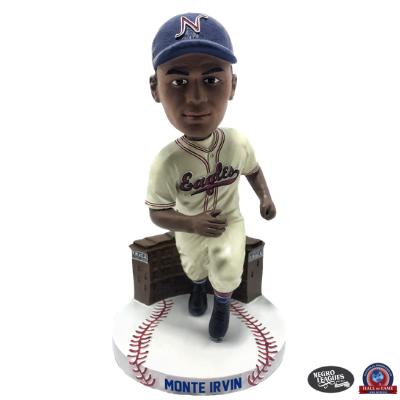
Monte Irvin
Monford Merrill Monte Irvin was a baseball player who played the left fielder and right fielder in the Negro Leagues and was one of the few who transitioned to Major League Baseball after the integration of the sport in 1947. Irvin played for the Newark Eagles, New York Giants, and Chicago Cubs. During his time playing for Giants, Irvin would be an MLB All-Star (1952) and a member of the team when the club defeated the Cleveland Indians in the 1954 World Series in four games. In 1955, Irvin was sent to the minor leagues, playing for the Minneapolis Millers in Minneapolis, Minnesota where he hit 14 home runs in 75 games.
Read More
Buy this bobblehead from the Bobblehead Hall of Fame.
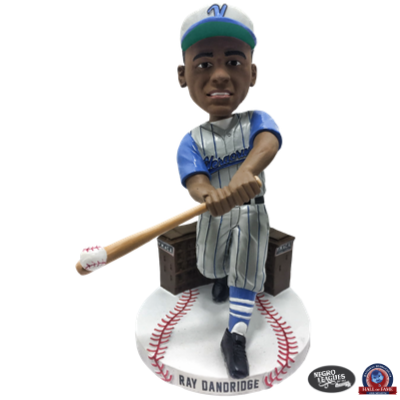
Ray Dandridge
Ray (Raymond) Emmitt Dandridge was a third baseman in the Negro Baseball Leagues. Dandridge was born on August 31, 1913 to Archie and Alberta Thompson Dandridge in Richmond, Virginia. Dandridge’s early childhood included playing baseball, football, and boxing. Dandridge had to quit playing football after suffering a leg injury and he began to focus on playing baseball. Dandridge was “discovered” by Candy Jim Taylor, manager of the Detroit Stars. In 1933, Dandridge signed to play for the Stars but the following year he joined the Newark (New Jersey) Dodgers who later became the Newark Eagles. Dandridge played with the Eagles from 1934 to 1938. During his time playing for the team, he was part of a legendary “Million Dollar” infield that included Dick Seay, Mule Suttles, and Willie Wells.
Read More
Buy this bobblehead from the Bobblehead Hall of Fame.
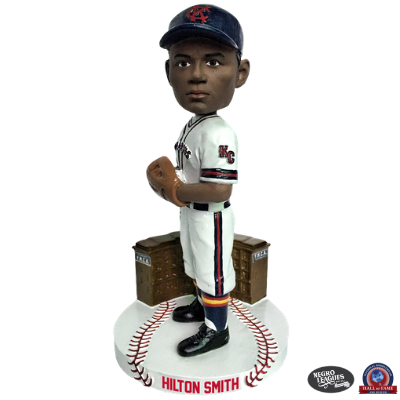
Hilton Lee Smith
Hilton Lee Smith was a right-handed pitcher who played for the Monroe, Louisiana Monarchs and Kansas City Monarchs.
Smith joined the Kansas City Monarchs in late 1936. During his time, playing with the team he was a six-time all-star (1937-1942) and Negro League World Series Champion (1942). The New Historical Baseball Abstract called Smith the best Negro Leagues Baseball Player in 1939, 1941, and 1942. From 1939 to 1942 he had extraordinary records that included baseball averages 25-2, 21-3, 25-1, and 22-5. Also, between 1944 and 1948, he had a .326 batting average. In 1945, Smith unsuccessfully urged his boss J.L. Wilkinson to sign young Jackie Robinson for the Monarchs.
Read More
Buy this bobblehead from the Bobblehead Hall of Fame.
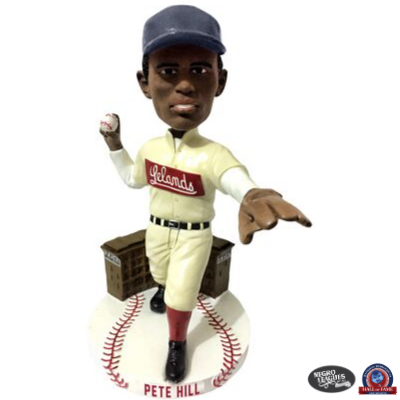
John Preston “Pete” Hill
John Preston “Pete” Hill was a baseball outfielder and manager for the Negro Leagues from 1920 to 1925.
Hill started playing professional baseball at the age of 17 in 1899 with the Pittsburgh Keystones in Pittsburgh, Pennsylvania. This was one of the many all-black teams that existed before the first Negro Baseball League was founded in 1920. Hill remained with the team for two years until he joined the Cuban X-Giants and played with them from 1901 to 1902.
Read More
Buy this bobblehead from the Bobblehead Hall of Fame.
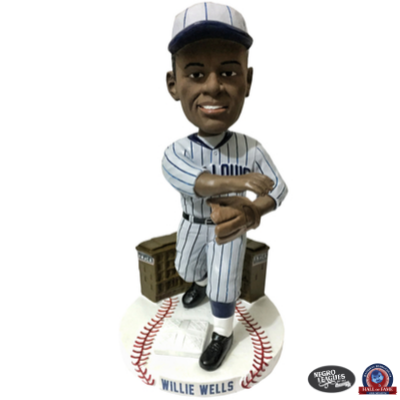
Willie James Wells
Willie James Wells, who gained the baseball nickname “The Devil,” was a baseball player who played shortstop during his baseball career playing for a record eleven Negro Baseball League teams in the United States as well as in Mexico and Cuba.
Wells eventually played for several teams during his career including the Chicago American Giants (1929, 1933-1935), Detroit Wolves (1932), Kansas City Monarchs (1933), Homestand Grays (1937), Newark Eagles (1936, 1938-39, 1942, 1945), Birmingham Black Barons (1941), New York Black Yankees (1945-46), Baltimore Elite Giants (1946), Indianapolis Clowns (1947), and Memphis Red Sox (1948). Wells also played in the Mexican League including Veracruz (1940-41, 1944), Tampico (1943), and Mexico City (1944). Wells was a 10-time Negro Baseball League All-Star (1933, 1934, 1935, 1937, 1938, 1939, 1939, 1942, 1942, and 1945. He was also a 2-time Cuban League MVP Award winner in 1929/1930 and 1939/40 for the Petroleros de Cienfuegos (Cienfuegos Oilers) and Almendares. Wells managed the Newark Eagles (1942 and 1945) and Indianapolis Clowns (1947).
Read More
Buy this bobblehead from the Bobblehead Hall of Fame.
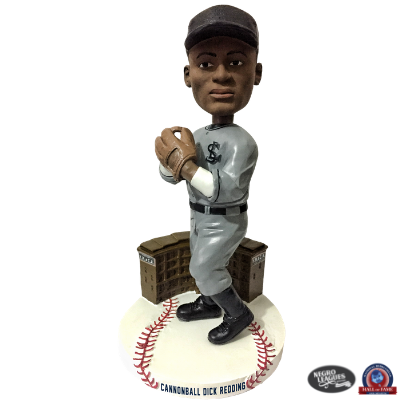
Richard “Cannonball Dick” Redding
Richard “Cannonball Dick” Redding was a pitcher, outfielder, and manager in the Negro Leagues. Redding was born on April 15, 1893 in Atlanta, Georgia. Much of his early life is unknown. Redding’s baseball career started in 1911 when at 18 he played with the Philadelphia Giants for the first half of the season before moving to New York to play with the New York Lincoln Giants. After joining the Lincoln Giants, he pitched and won for the time in 17 straight games.
In 1914, Redding joined the Lincoln Stars baseball team in New York City, New York. The following year he won 20 straight games for his new team and by August 1915, the press gave him the nickname, the Demon pitcher. In September 1915, he left the Lincoln Stars and rejoined the Lincoln Giants where he fashioned a 3-1 record that included a shutout and hitting a .385.
Read More
Buy this bobblehead from the Bobblehead Hall of Fame.
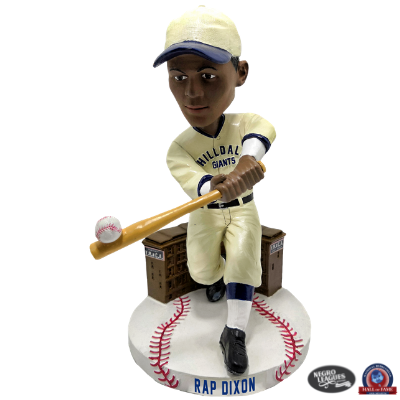
Herbert Alphonso “Rap” Dixon
Herbert Alphonso “Rap” Dixon was a Negro Baseball League (NBL) baseball outfielder. To avoid an upcoming high school assignment of dissecting a cat in science class, Dixon went to a local sporting goods store and spent the money he had saved from working on the weekends in a steel mill to purchase a new baseball glove. Dixon took a train to Atlantic City where he played for the Bacharach Giants. After a short stay, he returned home, continued baseball with the Steelton Giants, and returned to school.
In 1922 Dixon’s career as a professional baseball player started with the Harrisburg Giants of the Eastern Colored League. The Harrisburg Giants were the highest-paid team in Black baseball at the time. Dixon played for the Washington Potomacs briefly during the 1924 season, toured Japan in 1927-1928 on an All-Star team selected by Raleigh “Biz” Mackey, and in 1928 Dixon signed with the Baltimore Black Sox where he had the best hitting season of his career. Dixon had a .315 lifetime batting average, was a five-time All-Star, and achieved a still-standing record 14 straight hits in 1929 against the Homestead Grays.
Read More
Buy this bobblehead from the Bobblehead Hall of Fame.
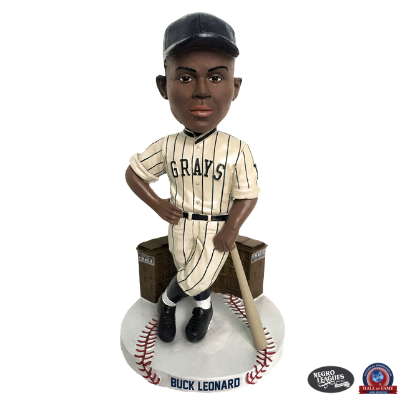
Walter Fenner “Buck” Leonard
Walter Fenner “Buck” Leonard was a professional baseball player who played the first baseman position in the Negro League Baseball and the Mexican League. Leonard was born on September 8, 1907 in Rocky Mount, North Carolina to John Leonard and Emma Leonard.
While working for Atlantic Coast Line Railroad he started playing baseball for two Rocky Mount black teams, the Rocky Mountain Elks and Daughtry’s Black Revel (later named Black Swans). After losing his job at the railroad in 1932, Leonard focused on playing professional baseball as a full-time career. In 1933, he joined his first Negro League Baseball team, the Baltimore Stars, where he played first base.
In 1952 Leonard began playing in the Mexican Baseball League. He played for four cities in Mexico, Torreon, Xalapa, Durango, and Obregon. In 1955, Leonard officially retired from baseball. After retirement he worked as a school truant officer, a physical education instructor, and started a real estate company. From 1962 to 1972 he was vice president for the Rocky Mount Leafs, a minor league baseball team. From 1973 to 1975 he held the same post with the Rocky Mount Phillies.
Read More
Buy this bobblehead from the Bobblehead Hall of Fame.
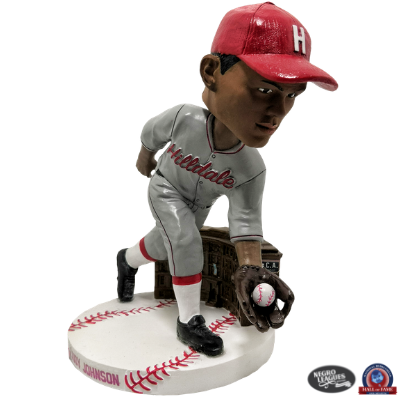
William Julius “Judy” Johnson
William Julius “Judy” Johnson was a professional baseball player in the Negro Baseball Leagues. He played third base and was a team manager from 1921 to 1937. Johnson was born on October 26, 1899 to William Henry Johnson and Annie Lee Jackson in Snow Hill, Maryland.
In 1923 he emerged as a star player and leader of the Daisies. The team won their first Eastern Colored League championship with Johnson batting .391. In 1924, the Daisies made it to the 1924 Colored World Series against the Kansas City Monarchs where they lost in five games. In 1925, Johnson and the Hilldale Daisies returned to the Colored World Series for a rematch against the Monarchs. This time they defeated the Kansas City team five games to one to become Negro World Series Champions. Johnson continued to play for the Daisies until 1929 when he signed with the Homestead (Pennsylvania) Grays as a player manager.
Johnson returned to the Daises in 1931, managing the team but left in 1932 when he signed with the Pittsburgh Crawfords. Although he was 33, he was still productive, hitting around .300 BA. Johnson was a two-time All-Star selection while playing with the Crawfords.
In 1937, Johnson was traded back to the Homestead Grays in exchange for players Pepper Bassett and Henry Spearman. He played a few games for the Grays until he announced his retirement from baseball in 1937.
Read More
Buy this bobblehead from the Bobblehead Hall of Fame.
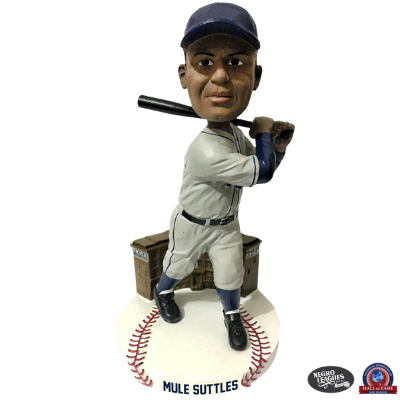
George “Mule” Suttles
George “Mule” Suttles was a power-hitting first baseman in the Negro Baseball League (NBL). Born on March 31, 1901 to James Suttles, a laborer in the coal mines and Early Griffin Suttles, occupation unknown, in Blocton, Alabama. Suttles worked in the coal mines during his teenage years.
His career included playing with the Chicago American Giants (1929, 1933-1935), Detroit Wolves (1932), and Washington Pilots (1932). Named to the East-West All-Star Game five times, Suttles hit the first home run in the game’s history in 1933. Suttles led the league in home runs twice and on August 11, 1935 during the East-West All-Star Game at Comiskey Park, he struck out once, drew four walks, and with the score tied in the bottom of the 11th inning with two men on base drilled a home run over the right center field fence giving the West an 11-8 triumph. Suttles later played with the Newark Eagles (1936-1940) and New York Black Yankees (1941). Although sources vary, Suttles is credited with 237 lifetime NBL homers.
Retiring from playing in the NBL at the age of 42, Suttles continued with the Newark Eagles as manager from 1943-1944. He managed a Newark, New Jersey bar in 1945 and the Newark Buffalos semi-pro team in 1946. He coached the New York Black Yankees of Rochester, New York in 1948 and umpired the East-West All-Star Game at Comiskey Park on August 22 of the same year.
Read More
Buy this bobblehead from the Bobblehead Hall of Fame.
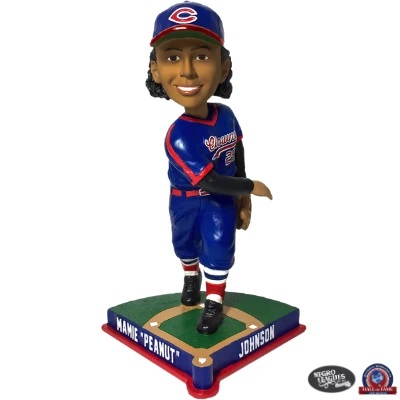
Mamie Lee Johnson
Johnson was born Mamie Belton on September 27, 1935, in Ridgeway, South Carolina, to Gentry Harrison and Della Belton Havelow. While her mother worked in Washington, D.C., Belton lived with her grandmother, Cendonia Belton, in South Carolina and attended Thorntree School. Belton’s love of baseball began when she was six years old. Along with her uncle, she made bats out of tree limbs, bases out of pie plates, and balls from rocks wrapped in tape. In 1945 after her grandmother had a stroke, Johnson moved in with family in New Jersey.
Johnson hit between .252 and .284 in each season she played. When she wasn’t pitching, she would play second base. Her batting average ranged from .262 to .284. Johnson won thirty-three games and lost only eight games during her career where she earned about $400 to $700 a month. Satchel Paige helped Johnson perfect her curve ball before their opposing teams went on to play each other. That episode is depicted in a scene from the 1992 movie, A League of Their Own. Johnson is the subject of the 2002 book A Strong Right Arm.
Mamie Lee Johnson retired from baseball in 1955, and after training, she had a second career as a Licensed Practical Nurse. She worked at Sibley Hospital in Washington, D.C. for forty years before retiring in 1995.
Read More
Buy this bobblehead from the Bobblehead Hall of Fame.
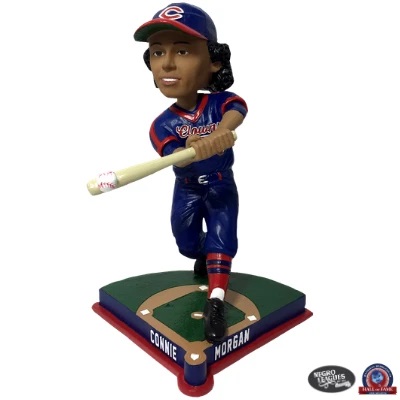
Constance Enola Morgan
Constance “Connie” Enola Morgan was one of the first three African American women to play in the Negro Leagues. Morgan first played baseball in high school as a catcher with the North Philadelphia Honey Drippers, an African American women’s baseball team for a total of five seasons. She played several positions, with a final batting average of .338. While in business school, Morgan read an article in the local newspaper about African American women playing for the Indianapolis Clowns, a Negro League team. She wrote the manager, Syd Pollack, and asked for a tryout. She was invited to come to a game in 1954 when the Clowns were in an exhibition game with the Baltimore Orioles. Pollack was so impressed with Morgan’s skills that he signed her to a two-year contract, replacing Toni Stone at second base.
Morgan stood at five feet four and weighed just one hundred and thirty-five pounds. She was called lightning fast when she had an opportunity to run the bases. She hit around .300, batting third in the lineup, and played in a total of forty-nine games.
A highlight of Morgan’s career was returning to Philadelphia for her first game in the city as a player for the Indianapolis Clowns at Connie Mack Stadium (formerly Shibe Park). The Clowns swept the doubleheader against the Philadelphia Monarchs.
Read More
Buy this bobblehead from the Bobblehead Hall of Fame.
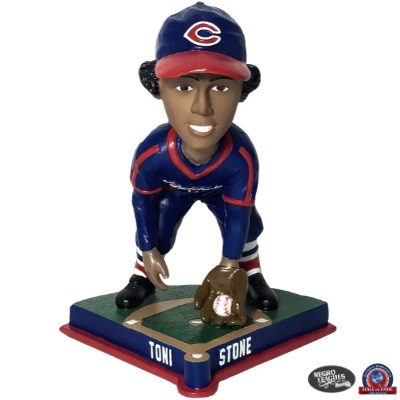
Toni Stone
Marcenia Lyle “Toni” Stone Alberga was the first of three African American women to play professionally in the Negro Leagues.
By the time she was ten years old, her parents invited a local Catholic priest over to talk her out of playing baseball, but instead the priest invited her to play with his team, the St. Peter Clavers, in the Catholic Midget League. Stone attended Roosevelt High School in Minneapolis but dropped out of school by the age of fifteen. She first played second base with the Twin Cities Colored Giants semipro team, a local barnstorming club which traveled around the Midwest and Canada.
During the 1936–1937 season, Stone worked out with the St. Paul Saints of the American Baseball Association. She moved to the California Bay Area to care for her sister Bunny and lived there from 1937 to 1946. She worked at a shipyard in the daytime as a forklift Operator, and at night, she worked at a cafeteria. While in San Francisco, Stone played for the Wall Post American Legion Team and the San Francisco Sea Lions in the West Coast Negro Baseball League, making about $200 to $300 a month. In 1949 she played a season with the New Orleans Creoles but left to play with the Black Pelicans, another Louisiana team.
Read More
Buy this bobblehead from the Bobblehead Hall of Fame.
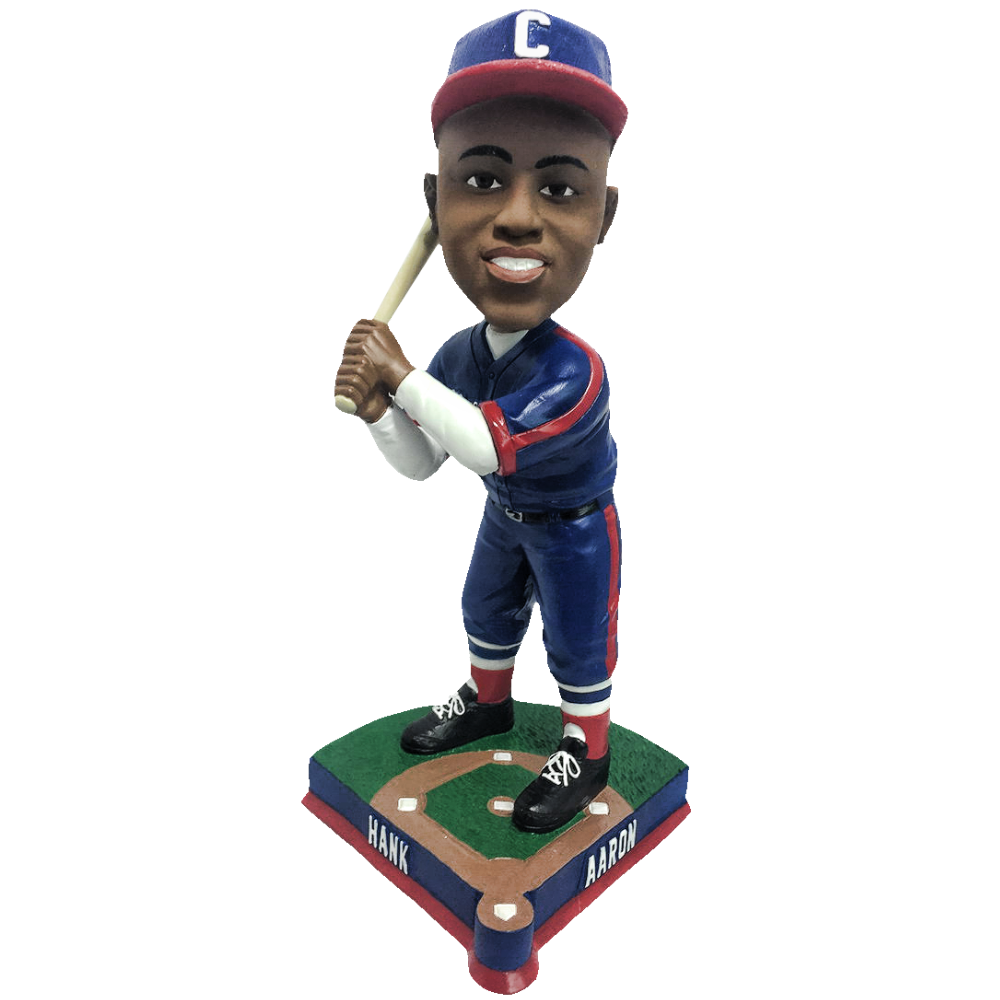
Hank Aaron
Henry Louis “Hank” Aaron decided he wanted to be a major league baseball player after hearing a speech by the Brooklyn Dodgers’ Jackie Robinson while visiting Mobile on April 3, 1950, during spring training. While in high school, Aaron began playing for the Mobile Black Bears, a semi-pro team, and in 1952 began a season with the Indianapolis, Indiana Clowns. Aaron was the last player to come from Negro Leagues and achieve success in Major League Baseball.
In 1954 Aaron was brought up to the Milwaukee Braves to replace an injured outfielder. Aaron hit a home run in his first major league at-bat. He would continue to hit home runs in remarkable fashion for the next two decades. Aaron was the only major league player to hit at least 20 home runs in every season for 20 consecutive years, at least 30 for 15 years, or at least 40 for 8 years. He was the first player to record more than 3.000 hits and 500 home runs. On April 8, 1974, Aaron hit his 715th career home run, breaking the record long held by Babe Ruth.
Read More
Buy this bobblehead from the Bobblehead Hall of Fame.
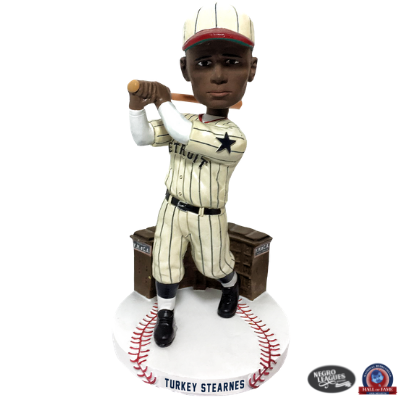
Norman Thomas “Turkey” Stearnes
Norman “Turkey” Stearnes was one of the Negro League Baseball’s (NBL) most feared hitters.
Winning the Negro Southern League pennant in 1932 and the Negro National League pennant in 1933 while playing with the Chicago American Giants, Stearnes played in a four-team doubleheader at Yankee Stadium in front of 30,000 fans in 1934, which at the time was the largest crowd ever to watch a black baseball event. Despite his success on the field, the Great Depression ended the ability of the Detroit Stars and other teams to pay salaries. Consequently, Stearnes moved around a lot, playing for the New York Lincoln Giants, Chicago American Giants, Philadelphia Stars before retiring in 1942 with the Kansas City Monarchs. Also, during off season (winters) Stearnes worked in a factory owned by Walter Briggs, who also owned the Detroit Tigers. At the time Stearnes was banned from this all-white team because of his race.
Read More
Buy this bobblehead from the Bobblehead Hall of Fame.
Teams
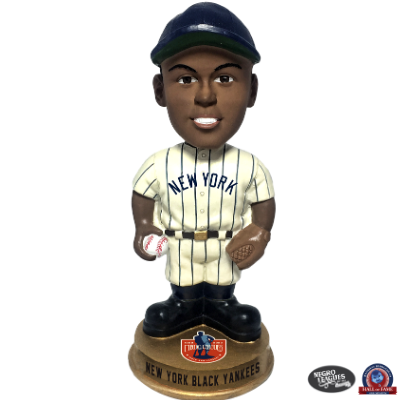
New York Black Yankees
The New York Black Yankees was a baseball team active in the Negro Leagues from 1931 to 1948. For most of their career the Black Yankees played their home games at Yankee Stadium in the Bronx, New York, although the 1938 season saw the team playing their home games at New York’s Triborough Stadium. The Black Yankees sent a succession of players to the Negro National Baseball League East-West All-Star Game from 1937 to 1942 and again in 1947 and 1948. However, while they enjoyed good attendance at home games, individual player success and its fortunes as a team were less impressive. In its 13 NNL seasons the team finished in last place ten times.
Buy this bobblehead from the Bobblehead Hall of Fame.
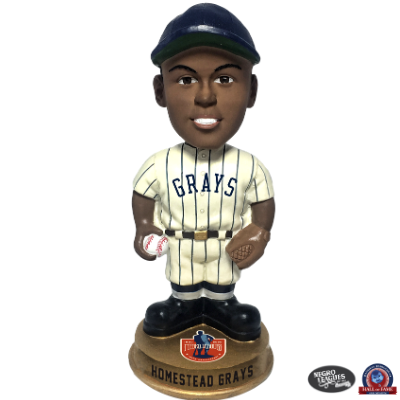
Homestead Grays
Homestead Grays was one of the most successful of the professional Negro League baseball teams. They won ten Negro National League Titles (1937-1945, 1948) and three Negro League World Series Titles (1943-1944, 1948), where they played the champion of the Negro American League. The team was based in Homestead, Pennsylvania, but played their home games at both Forbes Field in Pittsburgh and at Griffith Stadium in Washington, D.C.
Buy this bobblehead from the Bobblehead Hall of Fame.
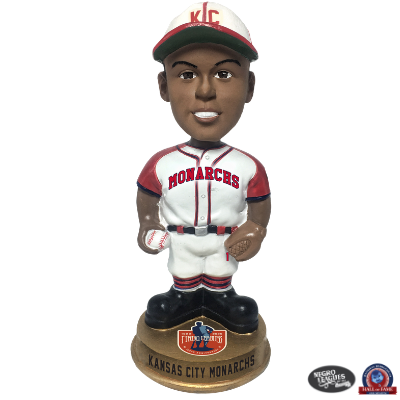
Kansas City Monarchs
The Kansas City (Missouri) Monarchs were the most prominent baseball team to play in the Negro Leagues. Formed in 1920, they were also the longest-running team in the Leagues, disbanding in 1965. Many famous players were on the Monarchs roster, including the hall of fame pitcher Satchel Paige, and the man responsible for breaking the color barrier in major league baseball, Jackie Robinson. The Kansas City Monarchs won several championships, including the first Negro League World Series in 1924.
Read More
Buy this bobblehead from the Bobblehead Hall of Fame.

Birmingham Black Barons
The Birmingham Black Barons was a professional baseball team active in the Negro Leagues from 1920 to 1960. They played their home games at Rickwood Field in Birmingham, Alabama. The team had its greatest success in the 1940s, winning three Negro National League pennants (1943, 1944, and 1949). Unfortunately, the Black Barons lost all three Negro League World Series games to the Homestead Grays of Pennsylvania.
Read More
Buy this bobblehead from the Bobblehead Hall of Fame.
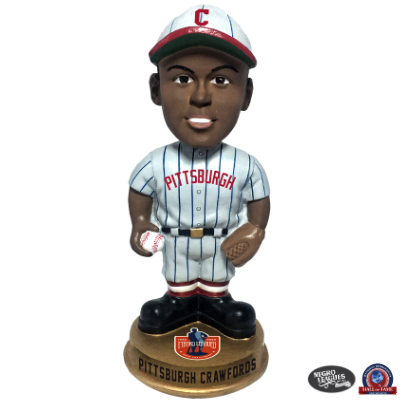
Pittsburgh Crawfords
The Pittsburgh Crawfords were a professional Negro League baseball team based in Pittsburgh, Pennsylvania. Pittsburgh was the only city in the country to be home of two of the Negro Leagues teams, The Homestead Grays, and the Pittsburgh Crawfords. The Pittsburgh Crawfords started off as the Crawford Colored Giants, an interracial semi-pro baseball team made up of local youth. At first there were two separate teams but they were combined to form a stronger unit. Local businessman W.A. “Gus” Greenlee purchased the team in 1931, renamed them the Pittsburgh Crawfords after his famous Crawford Grill club, and set out to create one of the best teams in the Negro league.
Buy this bobblehead from the Bobblehead Hall of Fame.
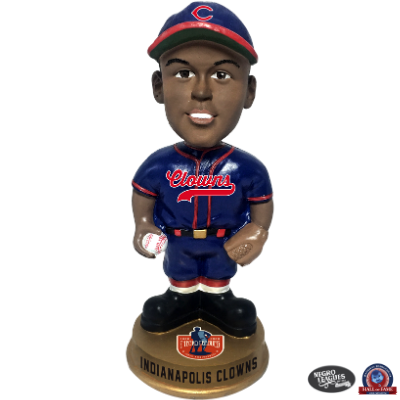
Indianapolis Clowns
Operating for 59 years, the Indianapolis Clowns, a Negro American League baseball team, was the longest playing black professional team in U.S. history. They were also the first team to have black women and white men as players. In the early years of this team, they changed names a few times from the Miami Giants that played in Miami, Florida in the Independent League and owned by Hunter Campbell and Johnny Pierce, to the Miami Ethiopian Clowns in the Negro Major League, and were known as the Harlem Globetrotters of baseball. The Clowns, like almost all established Negro League teams, struggled with attendance during the Great Depression. They, however, were the first to add comedy as an incentive to attract audiences. A player would often throw under his legs, or behind his back, while another read a newspaper at shortstop or first base. A catcher sat in a rocking chair while still able to throw out runners trying to steal second base.
Buy this bobblehead from the Bobblehead Hall of Fame.
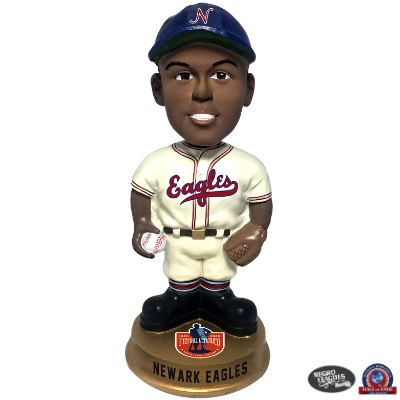
Newark Eagles
The Newark Eagles were a professional negro league baseball team formed in 1936. Abe Manley and his wife Effa, were owners and founders of the Brooklyn Eagles baseball team, established in 1935. The Manleys purchased the Newark Dodgers, established in 1933, and combined the two teams to form a single team. Effa managed the Eagles, making her the first black woman to own and operate a professional baseball team in a sport dominated by men.
The Eagles had an impressive roster which included pitchers Max Manning, Leon Day, and Don Newcombe, third baseman and infielder Ray Dandridge, center fielder Larry Doby (first black player in the American League), left fielder Monte Irvin, catcher James “Biz” Mackey, first baseman George “Mule” Suttles, and shortstop Willie Wells, all future Baseball Hall of Fame inductees.
Buy this bobblehead from the Bobblehead Hall of Fame.
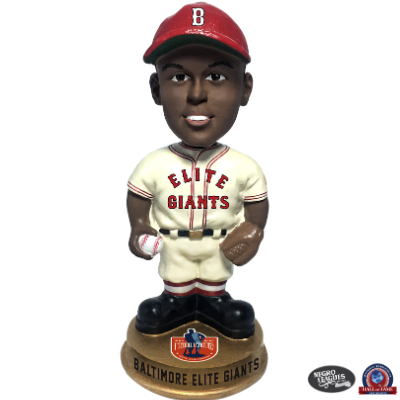
Nashville/ Baltimore Elite Giants
The Baltimore Elite Giants was a professional Black baseball team that played in the independent league as well as all of the Negro Leagues formed. The franchise had previously played in Nashville, Cleveland, Columbus, and Washington, before finding its home in Baltimore.
The team was originally established by Thomas T. Wilson, in Nashville, Tennessee, as the Nashville Standard Giants, on March 29, 1920. The semi-pro club was chartered by Wilson, J.B. Boyd, R.H. Tabbor, Walter Phillips, Marshall Garrett, W. H. Pettis, J. L. Overton, and T. Clay Moore. The original roster was compiled of players from the Nashville Maroons (formed in 1909) and the Elites (formed in 1913). The team was renamed the Nashville Elite Giants (pronounced EEE-lights) in 1921.
Buy this bobblehead from the Bobblehead Hall of Fame.
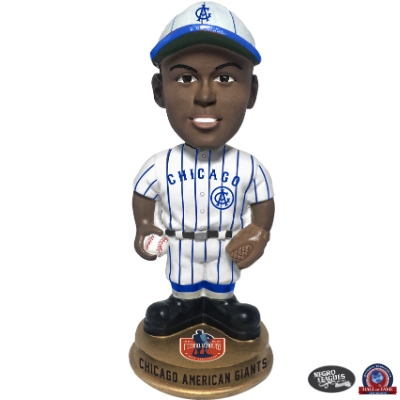
The Chicago American Giants
The Chicago American Giants were a Chicago-based Negro league baseball team, owned and managed from 1910 to 1926 by player-manager Andrew “Rube” Foster, known as the father of the Negro League Baseball. From 1910 until the mid-1930s, the American Giants were the most dominant team in Black baseball. Some of the most notable players in the team’s history were on the 1917 squad, before the establishment the Negro National League. That group included Bruce Petway, John Henry “Pop” Lloyd, Pete Hill, Frank Wickware, and “Cannonball” Dick Redding.
Buy this bobblehead from the Bobblehead Hall of Fame.
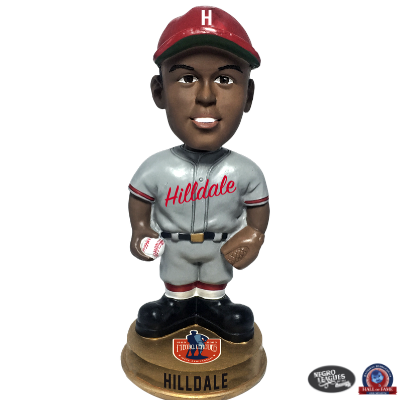
The Hilldale Athletic Club/ Hilldale Daisies
The Hilldale Athletic Club was a professional Negro League baseball team based in Darby, Pennsylvania. Austin D. Thompson, a 19-year-old ballplayer, established the team in 1910 as an amateur youth club. By the end of the year, Ed Bolden, a local black businessman and postal worker had taken over the club. In the early years, both men and women were a part of the roster making the Daisies the first gender-integrated team in black baseball.
The 1912 roster included Hulett Strothers, Raymond Garner, Billy Hill, George Kemp, Clarence Porter, Hugh “Scrappy” Mason, Frank “Chink” Wilson, Bill Anderson, Alice Robinson, Lloyd Thompson, Marian Caulk, Devere Thompson, Mark Studevant, Clara Ivory, Ed Bolden, Helen Barrett, Charles Gaskins, Mary and Grace Ricketts, Hubert Jackson, Sam Anderson and Leon Brice.
Buy this bobblehead from the Bobblehead Hall of Fame.
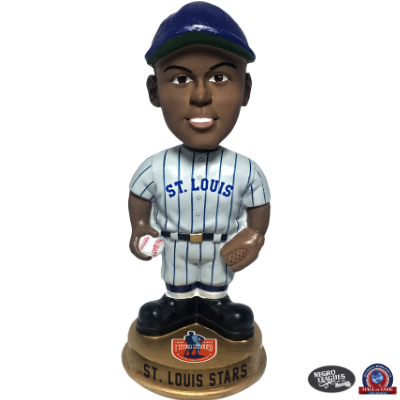
St. Louis Stars (St. Louis Giants)
The St. Louis Stars were a Negro League Baseball team that originally played independently, but later joined the National Negro League (NNL). The team’s original name was the St. Louis Giants, and it was formed in 1906 by African American bank messenger and baseball fan, Charles A. Mills. Mills was successful in his attempt to approach ballpark owner Conrad Keubler to invest in a local team called the Leland Giants. Former Leland Giants third baseman Dick Wallace became the new team’s manager, and during his tenure, Wallace assembled a core group of veteran players. He signed first basemen Ben Taylor and Tullie McAdoo, shortstop Joe Hewitt, catcher/ outfielder Sam Bennett, pitchers Bill Drake and Bill Gatewood, and outfielders Charles Blackwell and Jimmie Lyons.
Buy this bobblehead from the Bobblehead Hall of Fame.




Owners
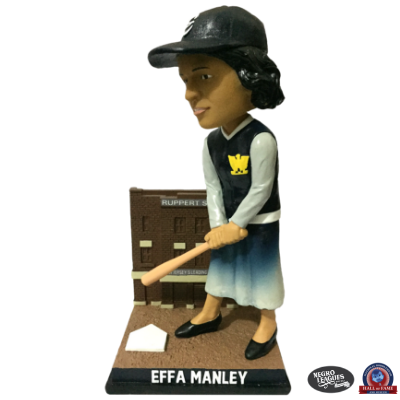
Effa Louise Manley
Effa Louise Manley, one of the first women of any race to run a baseball team, was co-owner, along with her husband Abe Manley, of the Negro League Baseball Team the Newark Eagles. In March 1936, the owners of the National Negro League (NNL) elected her husband as vice president. By 1941, Effa Manley was overseeing the day-to-day operations, marketing, and fiscal management of the Newark Eagles in Newark, New Jersey. She also did press interviews, made playing schedules, booked accommodations for the players on the road, publicized the games, purchased equipment, and negotiated contracts.
Effa Manley also supported civil rights and charitable endeavors. She was mainly responsible for organizing boycotts against white-owned businesses that refused to hire black employees in Newark, New Jersey. Manley helped raise money for the Harlem Women’s Club. She also donated money to the victims of the Ohio and Mississippi River valley floods in 1928. Manley was also a treasurer of the New Jersey National Association for the Advancement of Colored People (NAACP).
Read More
Buy this bobblehead from the Bobblehead Hall of Fame.
